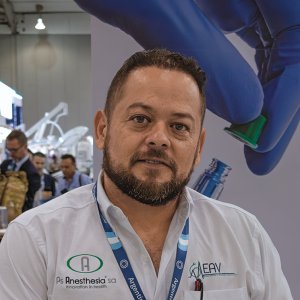Consultations Click on in Digital Era

STORY INLINE POST
Q: What are the main advantages and disadvantages of digital health for the patient and how can it improve patient outcomes?
A: Patient information security is an extremely important issue when speaking in terms of global healthcare. As the digital health era extends its reach, offering solutions to almost every corner of the world, the new health paradigm contributes a myriad of benefits. Technology can support both health professionals and patients to give and obtain a reliable medical service when handled appropriately.
A solid digital health infrastructure eases communication, as well as remote patient monitoring. Mobile technologies have established robust wireless solutions, wearable technology and mobile devices that automatically keep records of monitoring. Keeping patient records for ondemand cloud access empowers the healthcare and assists care providers across medical disciplines. This saves time and money. In Mexico, this is essentially groundbreaking as the public has almost no access to their personal health record. As most rural areas suffer from lack of access to quality medical services, digital solutions can be a barrierbreaker as telemedicine and teleconference in particular offer the ability to close that gap. As elderly, disabled and remotely located patients struggle to attend a doctor’s office, our model facilitates patient preparation, treatment, second opinions and follow-ups.
Our solutions encompass these three benefits of digital health, as we are complementing our teleconference services with a series of mobile apps focused on attending health concerns separately. We provide relevant software solutions, one of which is an app that reminds people to take their medicine, thereby contributing to medicine adherence. We aim to combine our telecommunications platform with our mobile development, to create a fully integrated solution.
Q: How does the technology support healthcare providers?
A: Our technology provides treatment beginning with an initial consultation at an online pharmacy, generating a digital prescription. The teleconference business model offers patients the ability to purchase time blocks within a doctor’s calendar, which makes scheduling easier for patients and doctors. Patients pay a lower fee for medical consultations, while doctors increase their earnings as they can charge more for 15-minute appointments than their typical hour-long consultation.
We are opening our technology to different sectors, such as education, legal advice and financial advice, to complement our medical solution. This year, we aim to build a complementary solution for general doctors, psychologists and nutrition professionals to incorporate technology into their processes. We are also launching online courses related not only to health but also business and sustainability to empower the digital era in Mexico and Latin America. Our goal is to provide intuitive digital tools attuned to our society’s healthcare system.
Q: How can you ensure that diagnosis is as accurate online as in person to the extent that a prescription can be given?
A: Our services for providers are by invitation only. We cannot offer a digital office for someone who does not meet our strict credential validation, in addition to completing our training sessions before attending patients. Not every medical consultation can be conducted online, but there are distinct situations wherein medical tests can provide support. The decision to treat a patient from a distance has to be that of the medical provider and patient. Both will discuss whether the treatment is suited to remote care. We contribute to preventive spaces for healthconscious individuals and on patient follow-up, which do not necessarily require patients to be present. A study conducted in the US of these types of services confirmed that patients believe that online therapy is almost as beneficial as face-to-face appointments. A great number of diagnoses can be carried out without the doctor ever coming into contact with the patient.
Q: How do you ensure your physicians have had the correct digital health training?
A: We are incorporating our technology into university programs, helping professionals acquire the skills to operate online. Our requirements for becoming an Astrum digital healthcare provider rely on robust background checkups, as well as confirming their medical training. We are carrying this out manually, but we are imitating regulatory authorities as they incorporate digital infrastructure into their operations. Besides technology adoption, there are doctors who already offer consultations over platforms such as WhatsApp and Skype so bridging the gap is easier. These efforts support the process as adoption of Astrum’s technology grows organically.
Q: How are you expanding your market within rural areas to ensure connectivity that will allow communities to use your products?
A: We recognize the issues surrounding connectivity. As we are not telecom hardware manufacturers, we see the need to collaborate to solve this shared predicament. Social entrepreneurship combined with telecommunications is already an emerging trend for business and we envision healthcare in that interaction. In Mexico, people with low incomes are increasingly acquiring technology to access the Internet and interact on social media. Mexico has seen some impressive developments in telecommunications, following the entry of AT&T for example. Where the population demands sophisticated connectivity, pricing is inevitably catching up and attuned to local needs. Our focus is on private medicine, followed by exploring the public health sector once we lower our costs even more.
We face a serious problem in Latin America with technology adoption, but are confident that these issues will be solved as the cost of telecom infrastructure drops. This paves the way for cheaper and better technology. The rising importance of telecommunications and its impact on business demonstrates that our service is one of the most economically viable projects that exist today, as we can contribute to governments saving money on disease prevention and facilitating medical consultation.
There is a blurry regulatory framework at the moment but data protection laws do apply to our technology, and we comply with them in their entirety. We are exploring regulatory options alongside the government to generate a new law-abiding protocol for such technological implementations. It is our job to ensure that medical professionals reach certain standards. There have been some important data breaches in the US, such that we are closely monitoring and updating our encryption standards. This requires us to work hand-in-hand with medical providers and patients to reinforce the importance of data security in their day-to-day operations as we all incorporate digital technology. This is a collaborative effort, as all high-impact industries understand. The success of our technology is undoubtedly a matter of education and although we can identify mistakes in past implementations, these are far from being considered failures. They are part of the learning curve.
Q: What are your main priorities for 2017 and beyond?
A: In 2017, we aim to prioritize education, health and social development through the data we receive from our technology. Our company hopes to incorporate the social media factor into technology development to enrich our users’ experience while learning what people want from our solutions. We are moving into the non virtual digital realms, where massive events hold a strong position. Sports, science fairs and continuing medical education through seminars and congresses complement our online solutions.
For the next five years, our goals are to provide an integrated IT solution moving into Artificial Intelligence. We aim to integrate our content and technology into university courses throughout the Spanish-speaking community, as well as joining forces with our Brazilian and Portuguese colleagues to produce similar solutions in their language. We hope to provide a complete content delivery infrastructure, where we can provide a one-stop marketplace for health and medical science for all our users.























